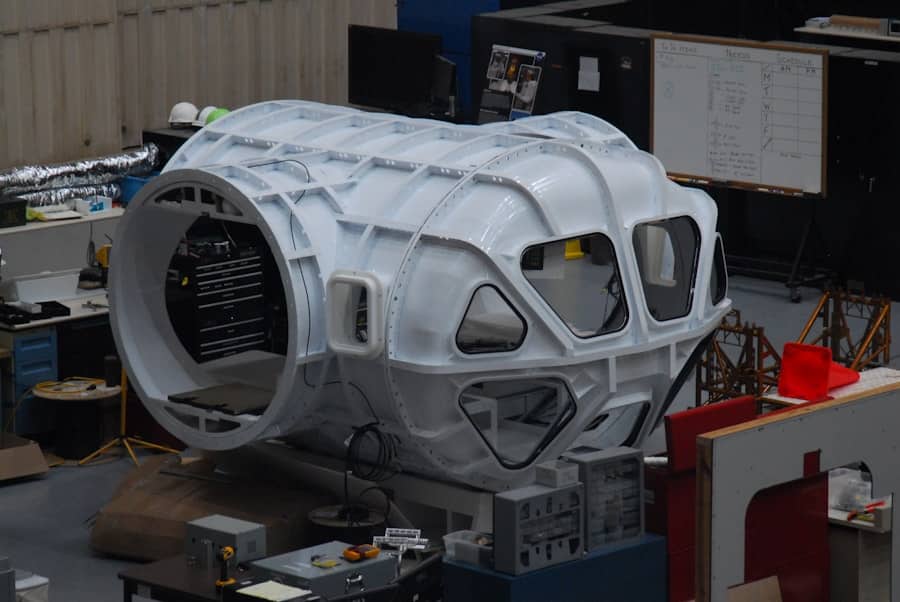The concept of modular spacecraft represents a significant evolution in the design and functionality of space vehicles. Unlike traditional spacecraft, which are typically built as monolithic structures, modular spacecraft are composed of interchangeable components or modules that can be assembled in various configurations. This innovative approach allows for a more versatile and efficient use of resources, enabling space agencies and private companies to tailor their spacecraft to specific missions and objectives.
The modular design philosophy is inspired by advancements in various fields, including computer technology and manufacturing, where modularity has proven to enhance efficiency and adaptability. The idea of modular spacecraft is not entirely new; however, recent technological advancements have made it increasingly feasible. The integration of lightweight materials, advanced robotics, and sophisticated software systems has paved the way for the development of spacecraft that can be easily reconfigured or upgraded.
This flexibility is particularly crucial in the context of long-duration missions, such as those planned for Mars exploration or deep-space research, where the ability to adapt to unforeseen challenges can significantly impact mission success. As we delve deeper into the advantages and potential applications of modular spacecraft, it becomes clear that this approach could redefine our capabilities in space exploration.
Key Takeaways
- Modular spacecraft are composed of interchangeable modules that can be combined in various configurations to create different spacecraft designs.
- Advantages of modular spacecraft include reduced development time, lower costs, and increased flexibility in mission planning and execution.
- Modular spacecraft offer flexibility and adaptability, allowing for easy upgrades, repairs, and reconfigurations to meet changing mission requirements.
- Cost-effectiveness of modular spacecraft is achieved through standardization of components, reduced development and production costs, and efficient use of resources.
- Potential applications of modular spacecraft include Earth observation, telecommunications, scientific research, and deep space exploration, among others.
Advantages of Modular Spacecraft
One of the primary advantages of modular spacecraft is their inherent flexibility. By allowing different modules to be combined in various configurations, these spacecraft can be customized for a wide range of missions. For instance, a modular spacecraft designed for a lunar mission could incorporate specialized modules for scientific research, habitat construction, or even resource extraction.
This adaptability not only enhances mission efficiency but also allows for rapid reconfiguration in response to changing mission parameters or objectives. The ability to swap out modules means that a single spacecraft can serve multiple purposes over its operational lifetime. Moreover, modular spacecraft can significantly reduce development time and costs.
Traditional spacecraft often require extensive testing and validation processes for each unique design, leading to lengthy development cycles. In contrast, modular designs allow for the reuse of existing modules across different missions, streamlining the development process. For example, NASA’s Lunar Gateway project envisions a modular space station that will serve as a staging point for lunar exploration.
By utilizing standardized modules that can be assembled and tested independently, NASA can accelerate the timeline for deploying this critical infrastructure in lunar orbit.
Flexibility and Adaptability of Modular Spacecraft

The flexibility of modular spacecraft extends beyond mere reconfiguration; it encompasses the ability to adapt to new technologies and scientific discoveries. As our understanding of space evolves, so too do the requirements for exploration missions. Modular spacecraft can be upgraded with new scientific instruments or technologies without necessitating a complete redesign.
This adaptability is particularly important in an era where technological advancements occur at an unprecedented pace. For instance, if a breakthrough in propulsion technology emerges, a modular spacecraft could be retrofitted with new propulsion modules to enhance its performance. Additionally, the adaptability of modular spacecraft allows for collaborative missions involving multiple space agencies or private entities.
Different organizations can contribute specialized modules tailored to their expertise or mission goals, creating a more comprehensive and capable spacecraft. This collaborative approach not only fosters international cooperation but also maximizes the potential for scientific discovery by pooling resources and knowledge from various stakeholders. The International Space Station (ISS) serves as a prime example of this collaborative spirit, where modules from different countries have been integrated into a single operational platform.
Cost-Effectiveness of Modular Spacecraft
Cost-effectiveness is a critical consideration in space exploration, where budgets are often constrained and resources limited. Modular spacecraft offer a compelling solution to this challenge by enabling cost savings through reusability and reduced development times. The ability to reuse modules across different missions means that investments in research and development can yield returns over multiple projects rather than being tied to a single mission’s success.
This reusability model is akin to how commercial airlines operate, where aircraft are designed for longevity and versatility across various routes. Furthermore, the modular approach can lead to economies of scale in manufacturing. By standardizing components and modules, manufacturers can produce larger quantities at lower costs per unit.
This reduction in production costs can make space missions more accessible to a broader range of organizations, including smaller companies and emerging space nations. For example, companies like SpaceX have demonstrated how innovative manufacturing techniques can drive down costs while maintaining high reliability standards. As more players enter the space industry, the cost-effectiveness of modular spacecraft will likely play a pivotal role in democratizing access to space.
Potential Applications of Modular Spacecraft
The potential applications of modular spacecraft are vast and varied, spanning scientific research, commercial endeavors, and even planetary colonization efforts. In scientific research, modular spacecraft can be deployed for missions ranging from Earth observation to deep-space exploration. For instance, a modular design could facilitate the deployment of multiple scientific instruments on a single mission, allowing researchers to gather diverse data sets simultaneously.
This capability is particularly valuable for missions targeting celestial bodies with complex environments, such as Europa or Enceladus, where understanding multiple factors is crucial for assessing habitability. In commercial applications, modular spacecraft could revolutionize satellite deployment and maintenance. Instead of launching individual satellites as standalone units, companies could deploy modular satellites that can be assembled in orbit.
This approach would not only reduce launch costs but also enable on-orbit servicing and upgrades. For example, if a satellite’s sensor becomes outdated or malfunctions, it could be replaced with a new module without requiring a complete satellite replacement. This capability would extend the operational life of satellites and enhance their functionality over time.
Challenges and Limitations of Modular Spacecraft

Despite their numerous advantages, modular spacecraft also face several challenges and limitations that must be addressed for widespread adoption.
Each module must be designed not only to function independently but also to communicate effectively with other modules within the spacecraft.
This requirement necessitates rigorous testing and validation processes to ensure that all components work seamlessly together during missions. Another limitation lies in the potential increase in weight and volume associated with modular designs. While individual modules may be lightweight, the need for additional structural support and interfaces can lead to an overall increase in mass.
This added weight may impact launch vehicle selection and mission profiles, particularly for missions targeting distant destinations where every kilogram counts.
Current and Future Developments in Modular Spacecraft Technology
Current developments in modular spacecraft technology are already paving the way for future innovations in space exploration. NASA’s Artemis program aims to establish a sustainable human presence on the Moon by utilizing modular components for its lunar Gateway project. This initiative will involve assembling various modules in lunar orbit to create a versatile platform for crewed missions and scientific research.
The lessons learned from this program will likely inform future endeavors on Mars and beyond. Private companies are also making strides in modular spacecraft technology. SpaceX’s Starship is designed with a modular architecture that allows for rapid reconfiguration based on mission needs.
The Starship’s ability to carry both crewed missions and cargo payloads exemplifies how modularity can enhance operational flexibility while reducing costs. As commercial spaceflight continues to expand, we can expect further innovations that leverage modular designs to meet diverse mission requirements.
The Future of Exploration with Modular Spacecraft
As we look toward the future of space exploration, modular spacecraft stand out as a transformative approach that promises to enhance our capabilities beyond what was previously imaginable. Their inherent flexibility allows for rapid adaptation to new technologies and mission objectives while promoting cost-effectiveness through reusability and collaborative efforts among various stakeholders. The potential applications span scientific research, commercial ventures, and even ambitious plans for human settlement on other planets.
While challenges remain in terms of integration complexity and weight considerations, ongoing developments in technology are likely to address these issues over time. As we continue to push the boundaries of exploration into deeper realms of space, modular spacecraft will play an essential role in shaping our journey into the cosmos, enabling us to explore new worlds with unprecedented efficiency and adaptability. The future of exploration is bright with the promise of modular designs leading us into uncharted territories beyond our planet.
In the rapidly evolving field of space exploration, the concept of modular spacecraft is gaining significant traction as a promising approach to future missions. These spacecraft are designed with interchangeable parts, allowing for greater flexibility and adaptability in various space environments. A related article that delves into the technological advancements supporting this trend is titled “Best Software for Working with Piles of Numbers.” This article, available here, explores the software tools that are essential for managing the complex data and calculations involved in designing and operating modular spacecraft. By leveraging advanced software, engineers can optimize the design and functionality of these spacecraft, ensuring they meet the rigorous demands of space exploration.
FAQs
What are modular spacecraft?
Modular spacecraft are spacecraft that are designed with interchangeable and replaceable modules, allowing for flexibility and customization in their design and function.
What are the advantages of modular spacecraft?
Modular spacecraft offer several advantages, including the ability to easily upgrade and replace components, adapt to different mission requirements, reduce costs through reusability, and enable rapid development and deployment of spacecraft.
How are modular spacecraft beneficial for exploration?
Modular spacecraft are beneficial for exploration as they can be tailored to specific mission needs, such as carrying different scientific instruments or adapting to different environments. This flexibility allows for more efficient and cost-effective exploration of various celestial bodies.
What are some examples of modular spacecraft in use or development?
Examples of modular spacecraft include NASA’s Modular Robotic Vehicle (MRV), which is designed for lunar exploration, and the European Space Agency’s (ESA) HERA mission, which aims to study the effects of asteroid deflection.
What is the future potential of modular spacecraft in exploration?
The future potential of modular spacecraft in exploration is significant, as they can enable a wide range of missions to different destinations, including the Moon, Mars, asteroids, and beyond. Their adaptability and reusability make them well-suited for the evolving needs of space exploration.

